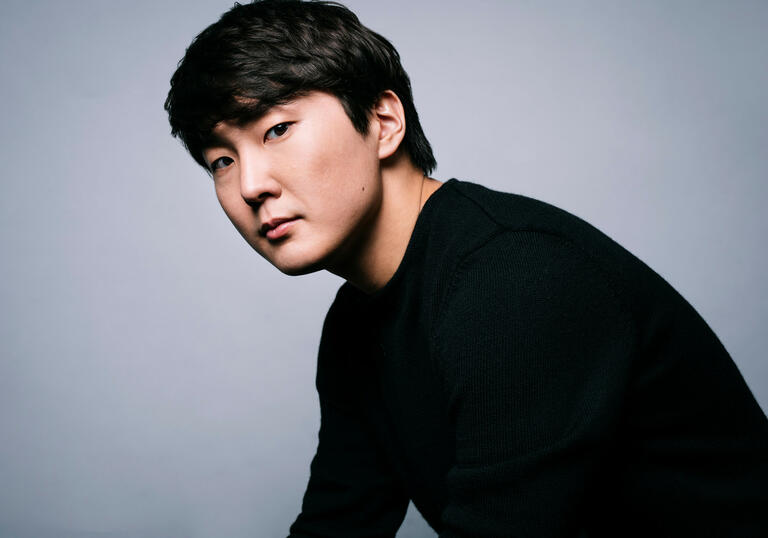
Programme and performers
George Frideric Handel Suite No 5 in E major, HWV430, The Harmonious Blacksmith
1. Prelude
2. Allemande
3. Courante
4. Air and Variations
Sofia Gubaidulina Chaconne
Johannes Brahms Variations and Fugue on a Theme by Handel
Johannes Brahms Klavierstücke, Op 76
1. Capriccio in F sharp minor
2. Capriccio in B minor
4. Intermezzo in B flat major
5. Capriccio in C sharp minor
Robert Schumann Études symphoniques
Seong-Jin Cho piano
Artist biography
With an innate musicality and profound talent, Seong-Jin Cho has established himself as one of the leading pianists of his generation and most distinctive artists on the current music scene.
Seong-Jin Cho came to international attention when he won First Prize at the Chopin International Competition in 2015, and his career has rapidly developed since. The following year he signed an exclusive contract with DG.
He works with the world’s leading orchestras, including the Berliner Philharmoniker, Wiener Philharmoniker, London Symphony Orchestra, Orchestre de Paris, New York Philharmonic and the Philadelphia Orchestra. Conductors with whom he regularly collaborates include Myung-Whun Chung, Gustavo Dudamel, Yannick Nézet-Séguin, Andris Nelsons, Gianandrea Noseda, Sir Simon Rattle, Santtu- Matias Rouvali and Esa-Pekka Salonen.
Highlights of this season include performances of the Brahms piano concertos at Baden- Baden Festspielhaus with the Chamber Orchestra of Europe under Yannick Nézet- Séguin; returns to the Bavarian Radio Symphony Orchestra under Zubin Mehta and Boston Symphony Orchestra under Andris Nelsons; and the world premiere of Thierry Escaich’s new piano concerto with the Czech Philharmonic under Semyon Bychkov. He also undertakes international tours with the LSO and Sir Simon Rattle, Dresden Staatskapelle and Myung-Whun Chung and the Academy of St Martin in the Fields.
As a recitalist he performs at many of the world’s most prestigious concert halls, including Carnegie Hall, Amsterdam Concertgebouw, Berlin Philharmonie, Vienna Konzerthaus, Munich’s Prinzregententheater, Suntory Hall, Tokyo, and Walt Disney Hall, Los Angeles, as well as at the Roque d’Anthéron and Verbier festivals. This season he gives solo recitals at Carnegie Hall, Walt Disney Hall, Alte Oper Frankfurt, Liederhalle Stuttgart, Laeiszhalle Hamburg, Berlin Philharmonie, Vienna Musikverein, Nagoya, Tokyo and Yokosuka and in Boston’s Celebrity Series; tonight marks his recital debut at the Barbican.
Seong-Jin Cho’s most recent recording, released in 2021, is of Chopin’s Piano Concerto No 2 and Scherzos with the London Symphony Orchestra under Gianandrea Noseda, following on from an album of the First Concerto (with the LSO and Noseda) and Ballades. His solo album titled The Wanderer was released in 2020 and features Schubert’s Wanderer Fantasy alongside sonatas by Berg and Liszt. Other albums include a solo Debussy recital and Mozart with the Chamber Orchestra of Europe and Yannick Nézet-Séguin. All have garnered widespread critical acclaim.
Seong-Jin Cho was born in 1994 in Seoul and started learning the piano at the age of six, giving his first public recital aged 11. In 2009 he became the youngest-ever winner of Japan’s Hamamatsu International Piano Competition. In 2011, he won Third Prize at the Tchaikovsky Competition in Moscow at the age of 17. From 2012 to 2015 he studied with Michel Béroff at the Paris Conservatoire. He is now based in Berlin.
Supported by
Supported by the Korean Cultural Centre UK. Celebrating 140 years of friendship between the UK and the Republic of Korea.
